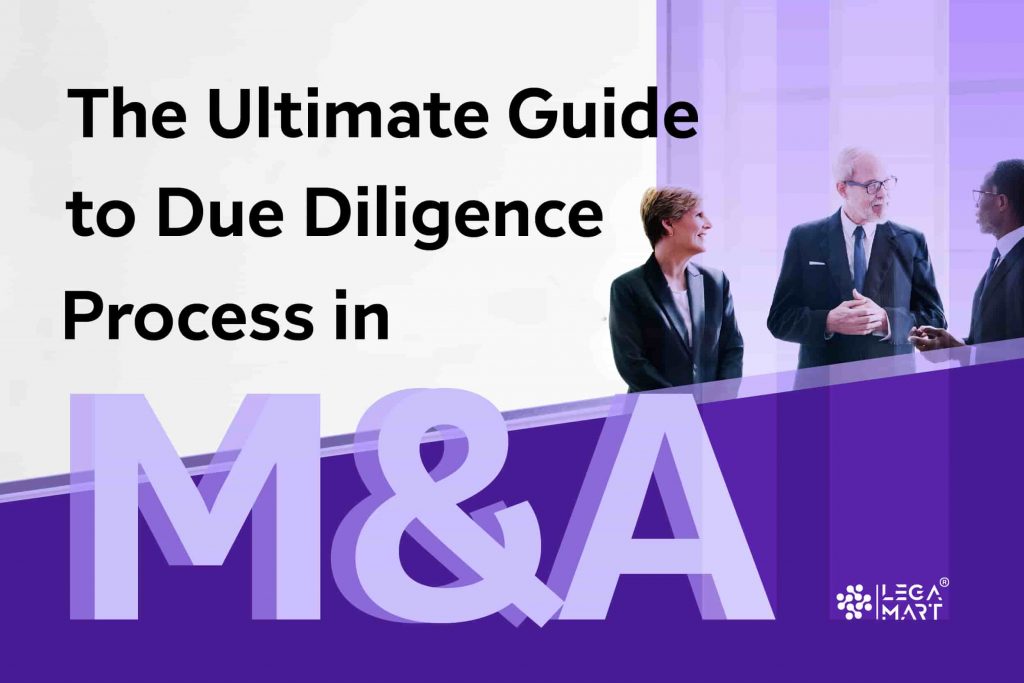- Introduction
- Importance of Due Diligence in Mergers and acquisitions
- Types of Due Diligence in M&A
- Conclusion
Introduction
Mergers and acquisitions (M&A) are complex business transactions that require careful consideration and analysis. Due Diligence in M&A helps assess the target company’s financial, legal, and operational status. The due diligence process seeks to aid the buyer in determining whether it wants to proceed with an acquisition and at what price. Due diligence is essential because it enables companies to undertake these transactions from an informed standpoint. Transactions that undergo a due diligence process offer higher chances of success.
Due diligence in M&A contributes to making informed decisions by enhancing the information available to decision-makers. In this guide, we will discuss the importance of due diligence in M&A transactions, its key components, and its impact on the success of the deal. We will also provide an overview of the due diligence process, including the different types of due diligence and the activities involved in each phase.
Importance of Due Diligence in Mergers and acquisitions
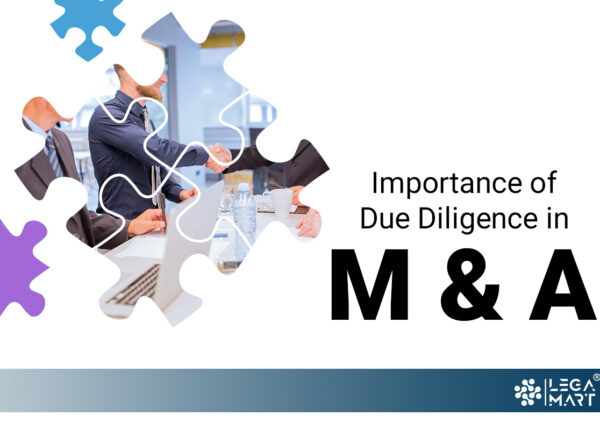
The importance of due diligence in M&A transactions cannot be overstated. Transactions that undergo a due diligence process offer higher chances of success. Due diligence contributes to making informed decisions by enhancing the information available to decision-makers. From a buyer’s perspective, due diligence allows them to feel more comfortable that their expectations regarding the transaction are correct. Purchasing a business without doing due diligence substantially increases the risk to the purchaser.
For a Buyer
The buyer needs to understand the risks and opportunities associated with the transaction and ensure they make a sound investment decision. Here are some reasons why due diligence is important for a buyer in M&A:
- Identify potential risks and liabilities: It helps the buyer to identify any potential risks and liabilities associated with the target company. This includes legal, financial, and operational risks. By identifying these risks, the buyer can make informed decisions about the transaction and take necessary measures to mitigate the risks.
- Assess the target company’s financial health: It enables the buyer to assess the target company’s financial health and determine its profitability, cash flow, and financial stability. This helps the buyer to make an informed decision about the fair value of the target company and negotiate a fair purchase price.
- Evaluate the target company’s assets and liabilities: It helps the buyer to evaluate the target company’s assets and liabilities, including any intellectual property, real estate, or other valuable assets.
- Understand the target company’s customer base: It enables the buyer to understand its customer base, including its customer demographics, sales channels, and customer satisfaction levels. This helps the buyer to determine the target company’s market position and potential growth opportunities.
- Identify potential synergies: It helps the buyer identify potential synergies between the target company and their existing operations. This includes cost savings, operational efficiencies, and cross-selling opportunities. By identifying these synergies, the buyer can determine the potential value of the transaction and negotiate a fair purchase price.
- Ensure regulatory compliance: It helps the buyer to ensure that the target company is compliant with all relevant regulations and laws. This includes environmental regulations, labor laws, and tax laws. By ensuring regulatory compliance, the buyer can avoid potential legal and financial liabilities.
For a Seller
Due diligence is equally essential for sellers to mitigate potential risks, identify value drivers, and improve their bargaining position. Below are some of the key reasons why due diligence is important for a seller in M&A:
- Identifying issues: Conducting due diligence allows sellers to uncover any potential issues, such as legal liabilities, compliance violations, or financial irregularities, that could reduce the value of their company or jeopardize the deal. By identifying and addressing these issues beforehand, sellers can mitigate the risks and increase their bargaining power during negotiations.
- Valuation: It provides sellers with an objective valuation of their company based on its assets, liabilities, revenue, and growth potential. This can help sellers to determine a realistic price for their company and to negotiate better terms with potential buyers.
- Improving the sale process: Sellers can prepare comprehensive documentation that details their company’s financial and operational performance, legal structure, contracts, and other key information. This can streamline the sale process and reduce the time and resources required to close the deal.
- Negotiation: It allows sellers to identify the strengths and weaknesses of their company, as well as those of potential buyers. This knowledge can help sellers to negotiate better terms, such as a higher price, favourable payment terms, or a reduced level of risk.
- Facilitating the transaction: Sellers can anticipate and resolve potential issues before they become deal breakers. This can help to facilitate a smoother transaction and reduce the risk of litigation or disputes after the deal is closed.
Types of Due Diligence in M&A
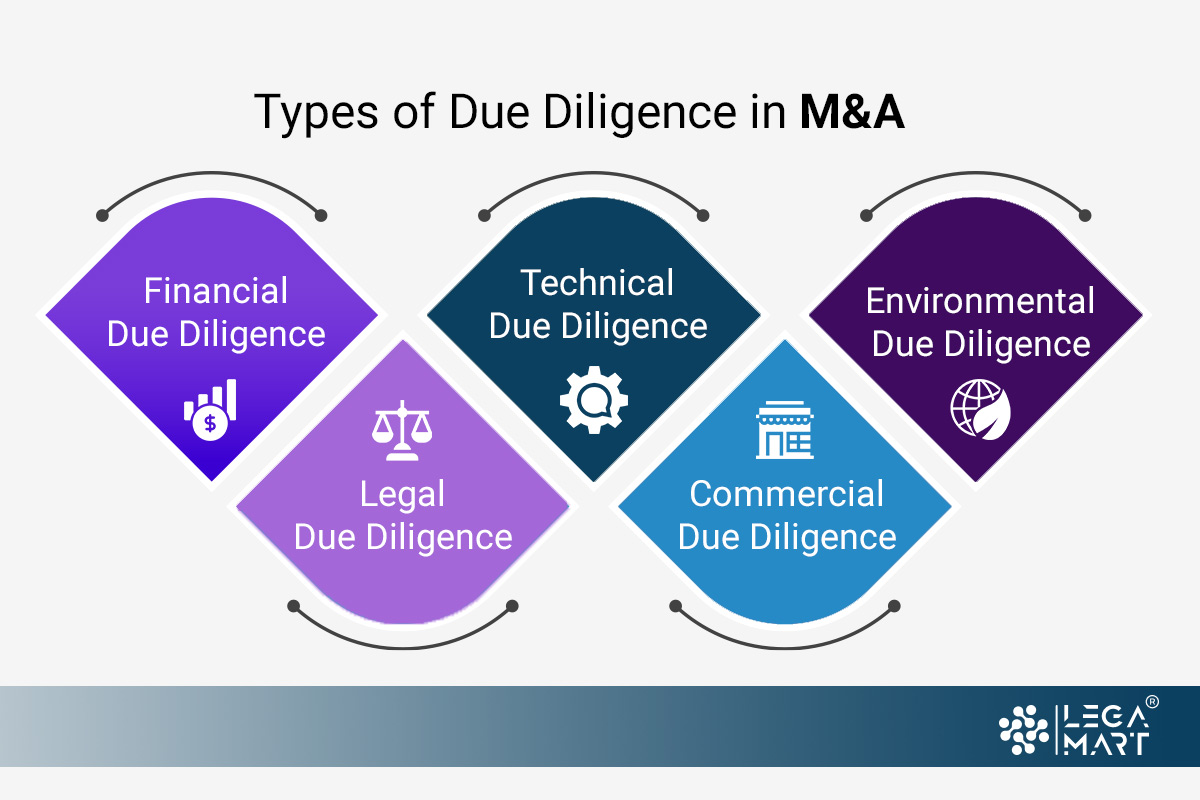
Financial Due Diligence in M&A
Financial due diligence in M&A, also known as accounting due diligence, is a necessary step in assessing the level of risk involved in investments. A structured approach is crucial for aligning the understanding of buyers and stakeholders and minimizing any misunderstandings during the transaction.
It is through financial due diligence that the financial health of a business is thoroughly examined, including its historical and current financial performance. This assessment is essential in determining whether the transaction will be financially advantageous for the buyer. Besides, as part of the financial due diligence process, the buyer’s team reviews the financial statements of the seller, which provide a summary of the accounting results for a specific time, including a fiscal or calendar year.
The main objective of financial due diligence is to establish future forecasts while taking into account any potential risks. A key aspect of financial due diligence involves scrutinizing financial statements, accounting policies, assets, debts, tax liabilities, cash flow, and projections to verify their accuracy and truthfulness.
Why is Financial Due Diligence in M&A Important?
- Having a mutual understanding of the target company’s financial position enables both parties to make an informed decision.
- It is crucial to comprehend the real financial performance of the organization.
- Financial due diligence provides crucial information that helps establish a fair purchase price and ensures that the purchase agreement contains the necessary warranties and representations.
- It helps assess the potential future state of the entity which is a critical determinant as to whether the deal will be successful or not for both parties.
- Transparency and assurance for the acquiring party.
Documents Required for Financial Due Diligence in M&A
The extent and reporting capabilities of the target company dictate the information required to carry out financial due diligence. The primary sources of information typically include;
- History of audited financial statements;
- Detailed trial balances/balance sheets;
- General ledgers/assets and liabilities;
- Detailed management accounts and reports;
- Current operating results; and
- Forecasted financial information/projections.
Financial due diligence in M&A checklist
A checklist for financial due diligence include:
- Audited financial statements, such as the cash flow statement, balance sheet, income statement, and footnotes, covering the past three years. These should be accompanied by an auditor’s report and quarterly and annual statements.
- Unaudited financial statements.
- Auditor’s correspondence for the past five years, particularly letters regarding the target’s accounting controls, this includes all Management Representation correspondences.
- An accounts payable schedule, particularly a schedule for any overdue or unpaid accounts that may affect the company’s profitability.
- A schedule of accounts receivable.
- The general ledger.
- Tax Information such as foreign, state, federal and local tax returns; excise tax filings; tax settlement documents for the past three years; and a schedule of undisclosed tax liabilities.
- Projections, which should include revenue by product type, customer, and channel, as well as all financial statements for instance, the balance sheet, cash flow statement, and cash on hand.
- An asset register including a copy of an up-to-date physical inventory of assets and equipment.
- Schedule of outstanding debt.
Legal Due Diligence in M&A
Legal due diligence involves the collection and evaluation of all legal documents and information related to the target company, allowing both the buyer and seller to examine potential legal risks.
During the Legal Due Diligence process, the acquiring company can determine if the target company has any ongoing legal proceedings and gain an understanding of the type of proceedings involved. Additionally, the acquiring company can investigate the target company’s contractual agreements, any legal restrictions, intellectual property holdings, and target markets.
Subcategories of Legal Due Diligence in M&A
There are various subcategories of legal due diligence, which include:
- Intellectual property due diligence: This subcategory focuses mainly on the examination and evaluation of the target company’s intellectual property assets, such as patents, trademarks, copyrights and trade secrets. It evaluates the strength and validity of the target company’s intellectual property portfolio and identifies any potential infringements or IP disputes, as well as evaluates any licensing agreements or other contractual arrangements related to the intellectual property;
- Business due diligence: this subcategory evaluates the target company’s business operations, financial performance, and other key aspects to determine the businesses’ overall value and potential risks; and
- Accounting due diligence: this subcategory evaluates the financial health and performance of the target company, including its financial statements, tax records, accounting systems as well as its internal controls.
What is the importance of conducting legal due diligence in M&A?
The benefits of legal due diligence are critical to an M&A transaction and include the following:
- Assessing the impact of potential liabilities, including judgment debts and legal fees, is important in determining the overall risk associated with a transaction. Moreover, the impact of such payments on the target company’s cash flow can be substantial and may negatively affect its valuation as a consequence.
- It provides valuable insight to the buyers about the target company. This is because, during the process of legal due diligence, all pertinent documents related to current or potential legal risks are gathered and assessed.
- Liabilities associated with litigation can impact the reputation of the target company, as well as its transaction purchase price, valuation, and profitability.
- It helps in identifying any existing issues that may impede the completion of the M&A transaction, if all parties have the knowledge of these issues, they can be in a position to discuss potential solutions to ensure a seamless transaction.
Documents Required for Legal Due Diligence in M&A
During a legal due diligence investigation, there are various types of documents that are examined to obtain information about the company and its current performance, these documents include:
Contracts
Contracts that must be reviewed include; –
- Customer and supplier contracts
- Operating contracts
- Partnership or joint venture agreements
- Guarantees and credit agreements
- Licenses
- Indemnification agreements
- Employment agreements
Organizational Documents
This documents include:
- Certificate of incorporation of the company
- Any limited liability agreement; and
- Stockholder agreement
Litigation documents
This includes documents regarding current and potential legal issues affecting the company, such as;
- Review of any pending claims
- Documents relating to litigation history including settled litigation and any litigations brought against the company
Legal Due Diligence in M&A Checklist
- Schedule of all company subsidiaries both direct or indirect
- Certificate of incorporation including Shareholder certificate documents as well as all shareholder agreements relating to management and ownership of the company.
- Documents related to previous financings or equity issuances, such as stock purchase agreements and registration rights agreements.
- Local/state/federal business licenses
- A schedule of all lands, buildings and any improvements owned or leased by the company.
- Occupational license
- All pertinent government permits, licenses, or authorizations including; building permits and Zonal and land use permits documents.
- Tax registration documents
- Power of attorney documents
- All correspondence between the company and its directors pertaining to indemnity, employment, loans and advances
- Previous or outstanding legal cases
Commercial Due Diligence in M&A
Commercial due diligence refers to the buyer’s systematic examination and assessment of a target firm’s commercial aspects with a view of furnishing the buyer with a comprehensive understanding of the company, covering its market position as well as its probable future evolution.
The purpose of conducting commercial due diligence is to comprehensively investigate, evaluate, and confirm the fundamental strategic justification and value generation proposition that form the foundation of an acquisition or financing deal.
Why is commercial due diligence in M&A important?
- It provides the buyer with an extensive comprehension of a target company’s current status as well as its long-term sustainability.
- It aids buyers and investors in making well-informed decisions and approaching negotiations with a realistic view of the enterprise by furnishing them with a profound insight of the company and its markets.
- It reduces transaction risks and facilitates negotiations related to valuation.
- Commercial due diligence uncovers possibilities for diversification and strategic expansion.
- It helps in identifying significant internal and external risks and proposes strategies to mitigate such risks.
Documents Required for Commercial Due Diligence
During a commercial due diligence investigation in M&A, several documents are typically examined to evaluate the target company’s commercial operations, market position, and growth prospects. These documents may include the following:
Legal documentations
- Outstanding contracts such as customer and supplier contracts, operating contracts, partnership or joint venture agreements and employment contracts.
- Organizational Documents such as certificate of incorporation and stockholder agreement
- Litigation documents such as schedule of pending claims as well as documents relating to litigation history.
- Income statement, balance sheet, cash flow statement of the business.
- Documents relating to sales trends and customer demographics.
- All data and history on the company’s products sold and completed transactions.
- Patents and trademarks documents and other intellectual property.
- Non-disclosure agreements relating to trade secret.
Commercial due diligence in M&A Checklist
A commercial due diligence checklist is beneficial to both parties, i.e employing a commercial due diligence checklist can assist the buyer in structuring their research or examining any third-party report to a seller, it helps in knowing which documents to prepare beforehand can be advantageous in saving time.
Outlined below is a comprehensive summary of the key components that a commercial due diligence checklist should cover:
Market Overview
- Key drivers in the market and its growth.
- Size and segmentation of the market including Industry-specific trends, demand, conditions, and threats segmented by market.
- What are the probable growth or transformation prospects in the future?
- Are the industry margins sustainable at current levels?
- Is the market online or in-person?
- Economic and political risks in the marketplace
- Key competitors (profiles, unique selling propositions as well as customer base)
Legal matters
- Policies and standards of conduct pertaining to compliance.
- Legal mandates such as court orders, judgments, injunctions, decrees, and settlements.
- Ongoing legal disputes.
- License agreements including any governmental licenses, permits and franchise agreements.
- Past and present governmental inquiries.
- Financing arrangements, loans, and lines of credit.
Assets
- Properties owned or leased by the company
- A schedule of fixed assets with locations.
- Agreement for the Purchase of Assets
- Stock purchase agreement
- Inventory documentation
- Fixed assets: Possessing a large number of fixed assets may indicate a reactive approach to market shifts.
Customers, Sales and Marketing
- What percentage of the yearly budget is allocated towards sales and marketing expenses?
- The profiles of the company’s customer
- Marketing strategies for the company’s products and services
- Company’s customer experience
General information
- Profile of the company including values, business mission and vision.
- The business’s operations locations.
- Summary of executive-level insights such as market analysis, business plan and strategic underpinnings
- Company ownership documents including details on directors, shareholders as well as their respective agreements and rights in the company.
Technical Due Diligence in M&A
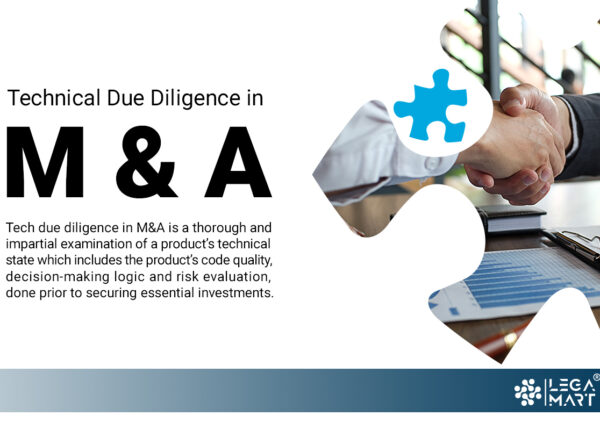
Tech due diligence in M&A is a thorough and impartial examination of a product’s technical state which includes the product’s code quality, decision-making logic and risk evaluation, done prior to securing essential investments.
Normally, an investor is the one who initiates the tech due diligence process. By conducting technical due diligence, the development team can gain a comprehensive understanding of the product’s strengths and weaknesses, while investors can verify that they are making an informed decision when considering investment in the product.
Documents Required for Technical Due Diligence in M&A
- It empowers the purchaser to acquire a thorough knowledge of the IT competencies, technology assets, data protection tactics as well as the general cybersecurity measures of the target company.
- It assists the purchaser in identifying significant risks that could affect their operations both presently and in the future, particularly, issues relating to integrating legacy systems.
Technical Due Diligence Documents
The documents that are typically reviewed during a technical due diligence investigation include; –
- Documents relating to product’s architecture, infrastructure, integrations and servers.
- Schedule of all IT assets.
- Reports on code quality.
- Intellectual property documents including licenses, patent applications, IP infringement records and IP regulatory compliance.
- Internal audit documents.
- Policies and procedure documentations.
- Products and services documents including architectural charts, software architecture and internal operations.
- Security mechanism and development frameworks documents.
Technical due diligence checklist
- Technological strategies
- Information technology infrastructure
- Technology processes and securities
- Tech staffing and their employment contracts
- Intellectual Property documents including ownership and licenses
Environmental Due Diligence in M&A
Environmental due diligence is an investigation that examines the environmental hazards and concerns that impact commercial property, which includes a comprehensive review of the site’s history, current operations, and surrounding areas to identify any existing or potential environmental risks and liabilities that may impact the property or business.
What is the Importance of conduction environmental due diligence in M&A?
- It identifies environmental risks and liabilities that are either current or could arise in the near future.
- It helps in evaluating the potential environmental liabilities of a target company which is a crucial step.
- It assists the buyers in determining the distribution of risks and liabilities after the completion of the M&A deal.
- It gives parties an opportunity to address any associated risks and liabilities and be able develop a negotiation strategy.
Documents to be examined during environmental due diligence
- Environmental audits and assessments documents
- Historical records including aerial photographs, historical topographic maps, fire insurance maps, and city directories,
- Regulatory records such as environmental regulations and laws at the local, state, and federal level
- Documents relating to construction cost estimate
- Environmental insurance policies
Environmental due diligence checklist
- Subdivision and parcel maps
- Record regarding the history of the property
- Title documents
- Public record documents
- Relevant restrictive covenants, easements as well as any agreements
- Survey
Steps Involved in Due Diligence in M&A
The Due Diligence in M&A procedure is organized in a manner such that each new piece of information obtained in relation to the business, helps to build upon previously learned information. By the end of the due diligence process, the entire procedure helps you in gaining a balanced view through a clarity on the pros and cons of your investment idea. This, therefore, allows the investors to make a rational decision related to the investment.
Pre-Transaction Due Diligence in M&A
The pre-transaction due diligence investigations are done prior to the final mergers, acquisitions, joint ventures, or investments. The aim behind pre-transaction due diligence is to gain exposure to any potential adverse legal, operational, financial, or other issues that might be capable of imposing legal costs and other professional fees, at a later stage. Therefore, a detailed report is prepared by a team of specialists who help the clients mitigate through the potential risks, and make an informed decision related to the investment.
Initial Research
The first step, similar to any other project, is to delineate the corporate goals of the merger or acquisition. You need to take into account the resources required and identify the main aim behind the merger and acquisition. Therefore, start with pinpointing the required resources, align them in a proper manner, and assure that the required organization aligns with your needs depending upon the initial research done about the company.
The M&A process may involve the inclusion of introspective questions about the company, or doing research related to the capitalization, revenues, margin trends, valuation, and competitors involved, among other things. The more you know about the company, the better it is, since it would help simplify the process ahead. Further, the M&A process can be slightly different for different countries like M&A process in UAE, M&A process in Brazil, M&A process in Iran etc.
Confidentiality Agreement
A confidentiality agreement is an agreement between two or more parties to ensure that the shared materials and information for due diligence are kept confidential by everyone involved.
During the merger or acquisition transaction, it is vital for confidential information to be shared with the other party, that is acquiring or merging with the company. Some examples of confidential information include company contracts, financial details, audit reports, and many other things.
However, considering that the deal is still at the initial stage, sharing the information is risky, since the party might later back out of the deal or refuse to merge or acquire the company. Therefore, ensure that the other party is bound by certain terms before they receive the confidential information. The other party must agree to respect the confidential information and keep it safe, rather than use it for the detriment of the company.
This can be done through the signing of the confidentiality agreement. The agreement is sometimes also known as a non-disclosure agreement (NDA). Ensure that you use critical wording in the agreement and make the agreement universally binding on the parties involved.
Information Request List
The process of Due Diligence in M&A includes the procedure of transferring information from one company to another, or from one company to the potential investor. Therefore, the investor is bound to request information about the company to make the final decision related to the investment.
This list is asked for, in addition to the questions asked of you and the other key members of the management team during phone calls or meetings. Some of the information that is asked for in the process, and that helps the investor in gaining information about the company are:
- Formation documents and operating agreements
- Ownership information and registration details
- Other investment and ownership interest in the company, or in any other entity held by the company
- Permits, licenses, and other government authorizations that might be necessary for the functioning of the company’s business, depending upon the jurisdiction
- Government authorities and correspondence copies
- Description, list, and owners of the intellectual property
- Details about all past and present litigations, investigations, claims, proceedings, arbitrations, and other legal procedures that the company might be involved in
- Contracts or material agreements of the company
- Financial statements and audit reports
- Accounting methods and treatments
- Historical cash flows
- Income statements and balance sheets
- Information on indebtedness and financial arrangements
- Monthly bank statements (for both active and closed accounts)
- Tax documentation
- Sales software data
- Merchant account statements
- Accounting systems
- Employment agreements and employees
- Organization chart and information on any departures
- Government inspection reports
- Sales materials, describing the products and services of the company
- Supply chain strategy and operations
- Description on IT systems and other platforms used by the company
- Material insurance agreements, along with details about the insurer, nature of risks covered, insured amount, and deductibles
- Correspondence related to cancellation or nonrenewal of any material insurance policy
- Workers Compensation Policy
And any other information that might be specific to the business of the company. As might have been portrayed from the above list already, you are required to provide all material information related to the company, irrespective of its nature.
Transaction Due Diligence Process in M&A
Transaction Due Diligence in M&A involves looking at the relevant sources of the company including the sources of value and risk, which act as the main factors that increase or decrease the chances of undergoing a successful merger or acquisition transaction. Other critical information involved in the process is compliance issues, tax and financial planning, cash flow determination, and identification of hidden costs.
Data Room
A due diligence data room is used to store important files and documents related to the M&A transaction, in a secure manner. These data rooms provide a single space for multiple parties to the transaction, and helps them access and request for information, along with sharing critical business information with investors, clients, and company leadership, through the internet in a secure manner.
Cloud storage is one such example of a data room which has helped the due diligence process in M&A become efficient, safe, and affordable for the parties. There are other software, such as DealRoom, which have managed to combine due diligence software and virtual online data room, into one single integrated program. These data rooms come with in-built features for setting permissions, sharing documents in a secure manner, and communicating with the parties efficiently. This electronic form of due diligence helps conduct the process in a cost-effective manner.
Therefore, due diligence data rooms help in the addition of value through the evaluation of costs, benefits, and risks associated with the decision. In fact, many jurisdictions have made the use of data rooms as a standard practice. One such example is the United States jurisdiction through the Securities Act of 1933.
Meetings with Management
One of the best ways to expedite the due diligence procedure is to conduct face-to-face meetings between the buyer’s advisors and the target company’s management. Therefore, it is beneficial to make arrangements with the legal advisors and other key advisors to meet the target company’s management team to identify, discuss, and resolve any key due diligence issues. This is also one way to open and build communication channels between both the parties, and have a transparent relationship not just during the due diligence in M&A, but after that as well.
After all, the existence of mutual trust between the advisor and the management saves time and ensures that the parties have the required understanding of the operations of the target company, and the expectations of the investor.
Interviews with Key Personnel
The Due Diligence in M&A should not just be limited to the management of the target company, but should also include other key personnel involved in the business. The most important people involved are the employees, investment bankers, accountants, attorneys, and consulting personnel.
The involvement of these key personnel help in gaining clarity about the true nature of services being provided by the company, along with the working of the company. While it might be possible that the management is happy with the profit margins, the company might have a low employee satisfaction rate, which is capable of affecting the company itself in the future. Therefore, the process of due diligence must include the interviews of key personnel, especially those who are involved in the day-to-day working of the target company.
Site Visits
Conducting site visits is one of the most important parts of the due diligence procedure. It is the duty of the potential investor to thoroughly inspect the property and confirm the true valuation of the assets involved. Performance of a commercial property inspection can be the start of this aspect. This can be done by checking the exterior of the workplace, reviewing the working conditions, analyzing the performance of mechanical and software systems, and many others, depending upon the nature of work involved.
Site visits not only help in analyzing the workplace, but also helps in understanding the environmental hazards, understanding the easement rights, and understanding the operations and capacity of the target company.
Third-Party Reports
Third-party Due Diligence in M&A is related to gaining more knowledge about the target company. Similar to interviews with key personnel, these inquiries help determine whether the third parties involved with the business are honest, trustworthy, and have refrained from using corrupt practices. If any of the third parties are found to conduct themselves otherwise, it is possible for the potential investor to lose confidence related to the engagement of the business with a bona fide third party.
Third-party due diligence is conducted using the primary and secondary resources available for the company and helps the potential investors to understand the unique attributes related to the target company, including information about the regions they operate in, number of third parties involved with the business, location of these third parties, risks associated with third parties, along with an idea about the internal working of the organization.
Post-Transaction Due Diligence
The Due Diligence in M&A is not just limited to the transaction but might also be required to be conducted subsequent to the business transaction to help identify any suspected fraud or an adverse event which might be capable of adversely affecting the business. The post-transaction due diligence might also be conducted to ensure an effective regulatory compliance procedure for the company.
Post-transaction due diligence helps in assuring the directors, shareholders, and any third-party stakeholders about the existence of constant monitoring. This not only helps in the mitigation of potential fraud and corruption, but also helps in the avoidance of reputational and financial costs through potential litigations, infringement of intellectual property, or money laundering investigations.
Integration Planning
Integration planning is one of the vital components leading to a successful M&A deal. While integration teams are involved from the start of the due diligence procedure and help in identifying the integration risks that may arise post the merger or acquisition, they further help in handling the integration issues after the transaction has been completed.
The integration team conducts discovery sessions with the target company’s management to identify integration strategies, target operating models, and the final organization structure post the acquisition process. The team is also responsible for identifying critical employees and their roles, credentials, skill sets, and their respective abilities to add value to the combined entity.
Post the transaction, they help in the assessment of any alignment or misfit issues that arise. These might include the cultural fit issues which might be capable of impacting the value realization. Finally, they help in resolving structural issues, address escalations, and monitor the performance of the transaction.
Ongoing Monitoring
Depending on the nature of customers and activities involved in the business, there might be businesses that are exposed to high risks. Some examples include financial institutions, or entities dealing in precious metals. These are areas which are politically exposed and have the threat of being sanctioned. Therefore, a constant check on the activities and businesses, and having a check on sanction compliance of the business forms an essential part of the ongoing monitoring mechanism within post-transaction due diligence.
This mechanism ensures that the risk profiles of the company have not been subjected to changes in a manner which are capable of exposing the firm towards any non-compliance or reputational damage.
Many companies have automated this process through the use of AI-generated options now available. However, the procedure might be personalized through the involvement of higher officials in the business. Some of the activities involved in the process are – the identification of purpose and the nature of changing business relationships, reassessment of third parties (clients) and the risks involved, establishing compliance with changing laws, and keeping a check on employee activities.
Challenges and Risks in Due Diligence in M&A
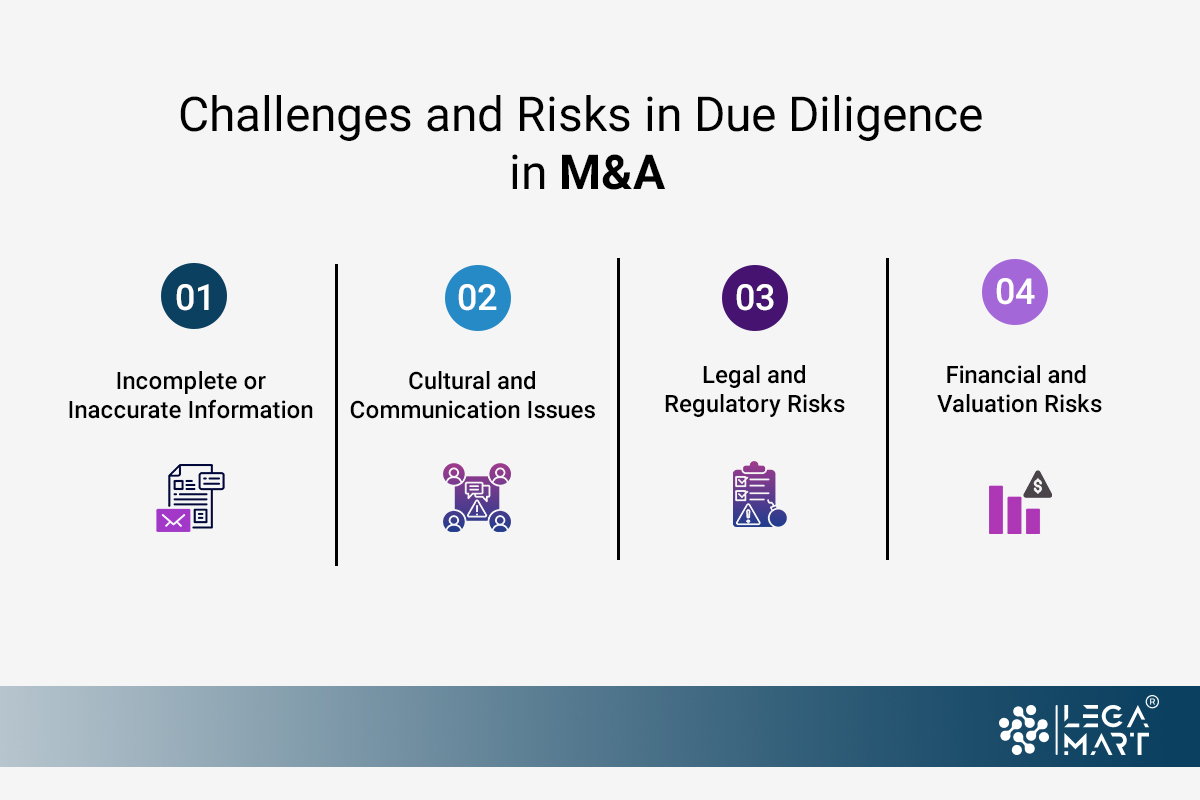
Incomplete or Inaccurate Information
Incomplete or inaccurate information provided during the due diligence in M&A can be a significant challenge during M&A due diligence as it can lead to a faulty assessment of the target company’s value and risk.
On the other hand, it may be risky to conduct M&A due diligence without complete or accurate information as the acquiring company may not be able to fully understand various issues pertaining to the target company, such as its financial performance, legal and regulatory compliance, intellectual property rights, sales, marketing and customer, as well as other critical factors.
Consequently, the target company may be subject to overvaluation or undervaluation, potentially leading to a failed acquisition or acquisition based on unfavorable terms. Moreover, incomplete or inaccurate information may also increase the risk of post-acquisition issues such as litigation or reputational damage.
Cultural and Communication Issues
Every company has its own culture, therefore, it is important that during the due diligence process, the buyer understands the target company’s culture and values and this will help to ensure that these issues align with the acquirer’s goals and values too. Besides, failure to take measures to align and harmonize the two cultures may cause M&A transactions to collapse/fail.
Lack of efficient cultural integration has caused most companies with robust organizational cultures to transform into dysfunctional organizational cultures. Therefore, failure to consider these cultural aspects can result in challenges during the integration process, leading to significant problems over time.
On the other hand, where parties to the M&A transaction have different languages or communication styles there can be a significant barrier to conducting an effective due diligence process in M&A. This is because different languages/communication styles can cause issues such as misunderstandings, lack of clarity, and misinterpretations which can negatively impact the deal negotiations and even lead to unsuccessful outcomes.
Legal and Regulatory Risks
It is vital to identify any legal or regulatory risks associated with the target company during the due diligence process so as to be able to address issues such as non-compliance with applicable laws and regulations, pending lawsuits or investigations, or potential violations of intellectual property rights. Failure to identify and address the legal and regulatory risks during the due diligence process in M&A can result in legal and financial consequences, depending on the applicable laws, including fines, penalties, litigation and even damage to reputation generally.
Financial and Valuation Risks
Financial risks include; inaccurate financial reporting, poor cash flow management and high debt levels. On the other hand, valuation risks may include overpaying for the target company or overestimating its future performance. During M&A due diligence, these issues have to be addressed through a detailed financial and valuation analysis in order to identify and mitigate any potential financial or valuation risks. Inaccurate valuation can result in a failed transaction or poor return on investment or even financial distress for the acquiring company while financial risks can cause a significant financial loss leading to a failed M&A transaction.
Challenges in Due Diligence and How to Overcome them?
Conducting due diligence is a complex process that often requires specialized expertise to gain a comprehensive understanding of a company. Numerous challenges can arise during this critical phase, and addressing them is essential. Here are some common challenges associated with due diligence and strategies to overcome them:
Not Knowing What Questions to Ask
Inadequate preparation can lead to a lack of clarity regarding the essential questions to ask during due diligence.
It’s crucial to plan your due diligence strategy well in advance. Identify the key areas to investigate and the specific questions that need answers. Engaging with experienced professionals can help ensure you’re asking the right questions to uncover vital information.
Slowness of Execution
Gathering necessary documents or information from sellers can be time-consuming and may cause delays in the transaction. Establish clear timelines and expectations with sellers to expedite the due diligence process. Encourage open communication to ensure a smoother and more efficient execution.
Incomplete Information
Sellers might not always have complete information readily available. This can be due to various reasons, including poor record keeping.
Understand that incomplete information doesn’t necessarily imply dishonesty. Work with the available data and communicate with sellers to fill gaps. Focus on the most critical information and adapt your strategy accordingly.
Lack of Communication
Sellers may perceive due diligence as burdensome, leading to impatience, inadequate communication, and potential conflicts.
Maintain a respectful and open line of communication with sellers. Address their concerns and offer support throughout the process to foster collaboration. Clear and transparent communication is key to overcoming this challenge.
Lack of Expertise
Due diligence often requires specialized expertise in law, accounting, or intellectual property. Determining when to seek external help can be challenging.
Assess your in-house team’s capabilities and limitations in conducting due diligence. When gaps in expertise are identified, bring in qualified professionals to bridge those gaps. Their experience can ensure a thorough evaluation of the company.
Cost Challenges
Due diligence can be costly, potentially leading some to consider cost-cutting measures.
Avoid the temptation to cut corners during due diligence. Investing in a comprehensive evaluation is essential to accurately identify potential risks and opportunities. Proper due diligence can prevent costly mistakes in the long run.
Using Information for Valuation
The due diligence process may unearth new information that can significantly impact the valuation of the company.
Once new findings emerge, engage with financial experts to recalculate the company’s valuation. Consider all relevant factors, including newly discovered inefficiencies or potential legal issues. Accurate valuation is essential for making informed decisions.
Best Practices for Due Diligence in M&A
Start Early
It’s crucial to begin due diligence as soon as possible, ideally before any deal terms are agreed upon. This allows ample time to gather information, perform analyses, and address any issues that may arise.
Assemble a Strong Team
Due diligence requires expertise across various disciplines, including finance, law, accounting, and operations. Assemble a team with the necessary skills and experience to conduct a thorough assessment.
Develop a Comprehensive Due Diligence Plan
Due Diligence in M&A requires expertise across various disciplines, including finance, law, accounting, and operations. Assemble a team with the necessary skills and experience to conduct a thorough assessment.
Maintain a Clear and Open Communication
Effective communication is essential to ensuring that all stakeholders are aligned and informed throughout the due diligence process in M&A. Regular updates and clear reporting can help prevent misunderstandings and facilitate timely decision-making.
Address Issues Proactively
Address Issues Proactively: Due diligence often uncovers areas for improvement or potential risks. Businesses should proactively address these issues and develop strategies to mitigate any identified risks before proceeding with the transaction.
Conclusion
Transactions that undergo a due diligence process in M&A offer higher chances of success. Due diligence contributes to making informed decisions by enhancing the quality of information available to decision-makers. From a buyer’s perspective, due diligence allows the buyer to feel more comfortable that their expectations regarding the transaction are correct.
Due diligence in M&A is a lengthy and intimidating process that involves multiple parties and phases. The process seeks to aid the buyer in determining whether it wants to proceed with an acquisition, and at what price. Ultimately, due diligence is a crucial step in the M&A process that can help ensure the success of the deal.
Frequently asked questions
Who Is Responsible for Conducting Due Diligence?
Typically, it falls upon the buyer and their team of external advisors to carry out the due diligence process. These external advisors may include industry experts who can analyze the company’s current business operations and growth prospects, audit and tax professionals, and legal experts.
Engaging external or third-party professionals early in the M&A (Merger and Acquisition) process is prudent. It serves as a valuable intermediary between the buyer and the seller, facilitating the resolution of potential areas of conflict. These external advisors play a crucial role in ensuring that both parties understand the reasoning behind each other’s perspectives, effectively reducing conflicts and enhancing the overall due diligence process.

